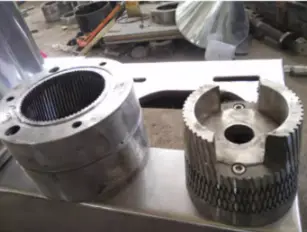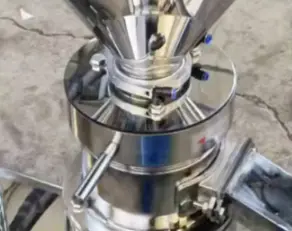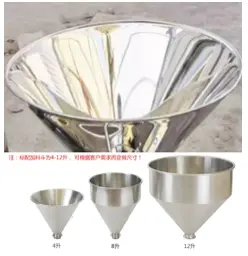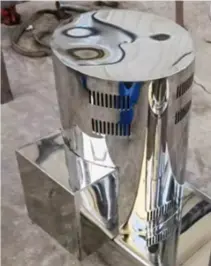Split stainless steel square outlet colloid mill machine
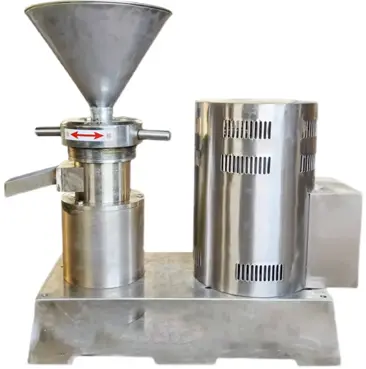
◆ What is colloid mil?
Let’s see colloid mill definition first. Colloid mill is a kind of fine grinding equipment. It is a machine for finely grinding and pulverizing fluid and semi-fluid materials. The composition of colloid mill mainly include a shell, a stator, a rotor, an adjusting mechanism, a cooling mechanism, a motor and other colloid mill parts. The colloid mill machine working principle is the relative motion through colloid mill rotor stator, the materials are acted upon by forces in the colloid mill rotor stator gaps, to achieving the purpose of crushing, emulsifying, and grinding, and finally obtaining the required products. This is also the purpose of colloid milling, and also shows how colloid mill works.
The colloid mill machine introduced here has a square outlet, so it can grind high-viscosity and large-particle materials. This colloid mill type is often used as colloid mill for peanut butter, colloid mill mayonnaise, etc. to process peanut butter, sesame paste, rice milk, minced meat, bean paste, moon cake filling and other materials. However, it is necessary to use large colloid mill machine models (colloid mill type 80 or above) and high-power colloid mills for grinding to improve colloid mill working efficiency and production efficiency, because they have bigger colloid mill capacity.
◆ Colloid mill specifications
| Product Name: | Split-type colloid mill machine |
| Model No.: | YSJTM-160 |
| Material processing fineness (um) | 2-50 |
| Output(colloid mill capacity) (t/h) | 0.2-8 t/h (Varies according to the nature of the material) |
| Motor parameters: | - |
| Power (kw) | 18.5 kw |
| Voltage (v) | 380 v |
| Colloid mill speed (n/min) | 2930 n/min |
| Rotor diameter (mm) | 130 mm |
| Machine size (L*W*H) (mm) | 1300*600*1100 |
| Machine weight (kg) | 300 kg |
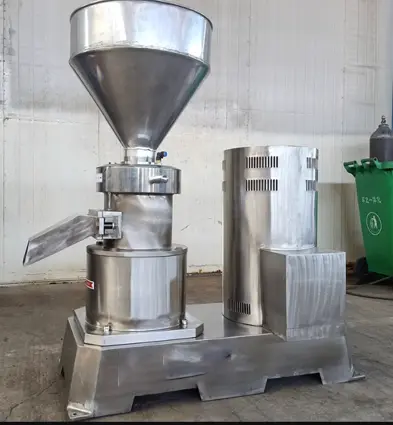
◆ Composition of colloid mill
The composition of colloid mill typically consists of the following main components:
Shell: The colloid milling shell encloses the internal colloid mill parts and provides structural support. It is usually made of stainless steel or other durable materials to ensure hygiene, corrosion resistance, and longevity.
Colloid mill rotor stator: The colloid mill machine contains a rotating component called the rotor and a static component called the stator. The rotor consists of a series of closely spaced, slotted discs or cones that rotate at high speeds. The stator surrounds the rotor and has matching slots or grooves that create a shearing gap with the rotor. The colloid mill rotor stator are typically made of high-quality stainless steel or other materials that are resistant to wear and corrosion. However, since it is the main working part of the colloid milling machine, it will inevitably suffer wear and damage after colloid mill working for a long time, so you can prepare some as colloid mill spare parts.
Drive Mechanism(Motor): The colloid mill is equipped with a drive mechanism, such as an electric motor, that powers the rotation of the rotor. The drive mechanism is connected to the rotor shaft and provides the necessary torque and speed for efficient milling.
Inlet and Outlet: The colloid mill machine has an inlet and an outlet port for the ingredients to enter and exit the milling chamber. The colloid mill inlet allows the ingredients to be fed into the milling gap between the rotor and stator, while the colloid mill outlet facilitates the discharge of the processed colloidal suspension or emulsion.
Adjusting Mechanism: Most colloid mills have an adjusting mechanism that allows the operator to control the gap between the colloid mill homogenizer rotor and stator. This adjustment helps regulate the colloid mill particle size or droplet size of the milled product.
Cooling or Heating System (Optional): Depending on the specific application, a colloid mill grinder may be equipped with a cooling or heating system. This system helps maintain the desired temperature during the colloid milling process, ensuring optimal product quality and consistency.
It's important to note that the exact design and composition of colloid mill can vary between manufacturers and specific models. Different modifications and additional features may be incorporated to meet specific processing requirements or industry standards.
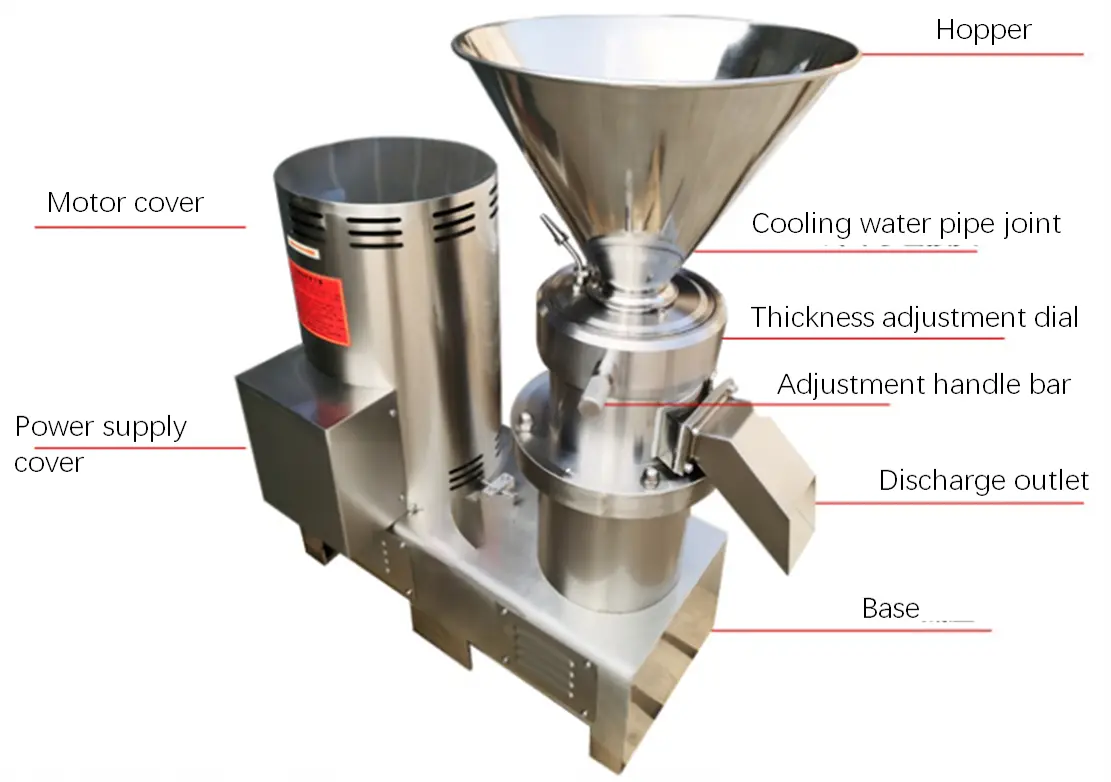
◆ Colloid mill details
-
• colloid mill rotor stator;
colloid mill rotor stator is made of heat-treated alloy steel, which is more wear-resistant, more delicate and has a long service life. -
• Adjustment handle
The adjustment handle of the colloid milling machine can adjust the grinding thickness of the material. Clockwise rotation can grind the material finer, and counterclockwise rotation can grind the material coarser. -
• stainless steel hopper;
The hopper of the homogenizer colloid mill is made of stainless steel, which is safe and hygienic. You can also add a screw feeder into the hopper for faster feeding and high production efficiency. The hopper capacity is optional to meet the needs of different customers. -
• Motor
Our colloid mill uses high-quality motors with optional power and models, which are durable, low-noise, and have long service life. It is installed with a motor cover to make colloid mill operation safer and the materials more hygienic.
◆ Advantages of colloid mill
● The colloid mill material is food grade stainless steel material. Except for the motor, all colloid mill parts that are in contact with the processed material are made of stainless steel. Especially the key colloid mill spare parts – the colloid mill rotor stator, have been strengthened. The colloid mill has good corrosion resistance and wear resistance, it makes the processed materials clean and non-pollution.
● The colloid mill is an ideal processing equipment for processing fine materials. It has compact design, good sealing, stable colloid mill properties, the colloid mill operation is also convenient, and has high production efficiency.
● The motor of the split colloid mill type is separated from the colloid mill base. This make the colloid mill properties be more stable, and the motor of the colloid mill also has longer service life than other colloid mill types. This colloid mill construction design can avoid the material leakage and burn out the motor. It is also high-quality sealing, corrosion resistance, and fewer failures. This colloid mills is driven by a pulley, changing the transmission ratio and increasing the colloid mill speed, so that the material can be crushed more finely.
● The motor voltage of our colloid mill is 220V and 380V(optional), with compact colloid mill construction, small size, light weight, reliable sealing structure, and the colloid mill working can be continuously for a long time. It is especially suitable for small businesses users and laboratory test work.
The stainless steel colloid mill is a grinder which used to grind materials, it is made of stainless steel which make it be strong and durable. This colloid mill type has a simple structure, is not easy to rust and oxidize, and is not prone to chemical reactions with raw materials, so has a long service life and is easy to clean. The colloid mills function is to crush the materials and finally get the corresponding products. Here are some examples of colloid mills: processing peanuts into peanut butter, soybeans into soy milk, rice into rice milk, peppers into chili sauce and other products. You can also contact us to learn more example of colloid mill.
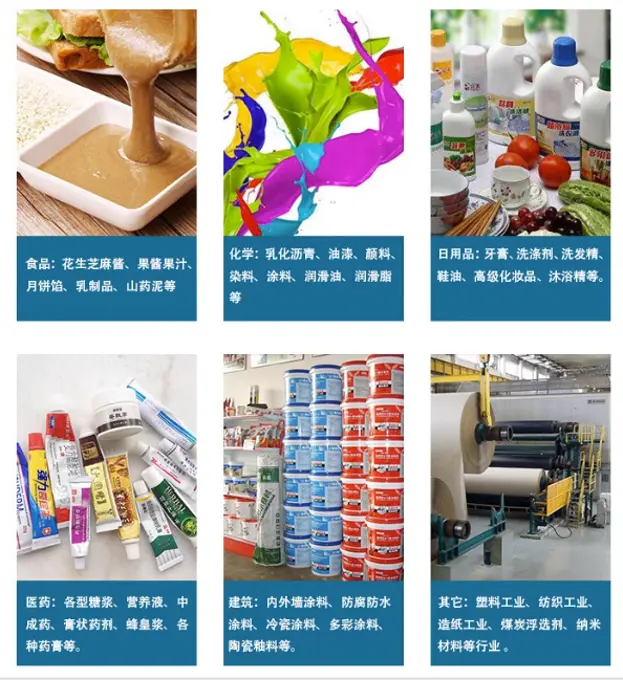
◆ Colloid mill type
There are many colloid mill types and colloid mill specifications. The colloid mills can be divided into split colloidal mill type, vertical colloid mill and horizontal colloid mill according to different colloid mill construction. There are also various colloid mill examples such as colloid mill for peanut butter, colloid mill mayonnaise, colloid mill coffee, colloid mill emulsion, colloid mill pharmaceutical, colloid mill asphalt emulsion, bitumen emulsion colloid mill, fungsi colloid mill according to their application fields. They can also be divided into large colloid mill, small colloid mill, laboratory colloid mill etc. according to the colloid mills usage. According to the hygiene level, the colloid mills can be divided into stainless steel shells and non-shells. You can choose the colloid mill type and colloid mill specifications according to your real production requirements.
◆ Factors affecting the colloid milling grinding effect
1. The influence of colloid mill speed: The greater the shear speed of the colloid mill rotor stator, the stronger colloid mill particle size reduction ability, and the better the grinding effect;
2. The structure of colloid mill rotor stator: The tooth structure of colloid mill rotor stator is divided into primary teeth, medium teeth, fine teeth, and ultra-fine teeth. The finer the teeth, the better the grinding effect will be;
3. Material viscosity: This refers to the residence time of the material in the colloid mill cavity. When you use the same colloid mill, smaller flow rate will has the better the grinding effect;
4. Number of cycles: The more cycles the colloid mill working, the better the grinding effect will be.
◆ The colloid mills usage of different colloid mill type and specifications
● vertical colloid mill-circulation tube type: suitable for the grinding of thin materials that require circulating backflow grinding like Juice, drinks, soy milk etc.
● vertical colloid mill-square outlet type: suitable for grinding medium and high concentration materials without backflow grinding, suitable for grinding peanut butter, chili sauce, etc. with medium colloid mill capacity output.
● split colloid mill type 100 - 7.5KW: It is suitable for grinding fine and coarse materials with high colloid mill capacity output, can use for grinding fish sauce, pork rinds, onion rings, etc.
● split colloid mill type 120 - 7.5KW: It is suitable for grinding thin materials and high-concentration materials. The colloid mill capacity output is relatively high and can be used with high productivity. It can be used for grinding mung bean filling, moon cake filling, chicken juice and other materials.
● split colloid mill type 140 - 11KW: It is suitable for grinding both fine materials and high-concentration materials with high output. It can be used at high production capacity and is suitable for users in mass production.
There are many colloid mill uses. As long as the fluid material is not very hard, it can be ground with a colloid mill machine. The grinding fineness can reach ultra-fine crushing. The larger colloid mill model has the wider uses of colloid mill, and the colloid mill capacity output will be higher too.
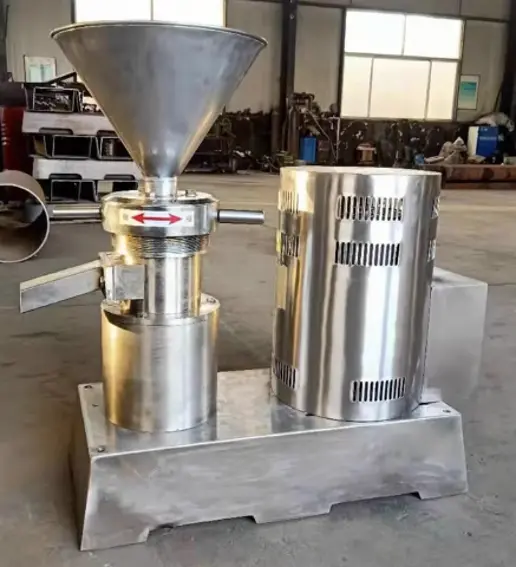
Here are some points you need to pay attention to when grinding thicker materials with industrial colloid mill machine:
1. When using a colloid mill peanut butter to grind peanut butter, we need to put the peanuts into the oil pan to squeeze the oil and then grind them in the colloid mill machine. Before pouring the peanuts, first pour few oil in colloid mill peanut butter to discharge the air in the colloid mill rotor stator, and then add peanuts. The grinding method for tahini is the same as the grinding method for peanut butter.
2. When using vertical colloid mill to grind rice milk, we need to soak the rice in water for 5-8 hours to make the rice full of water. Because this colloid mill is a colloid wet mill]. When the rice swells, pour few water first, and then gradually add the mixture of water and rice.
3. When using a colloid mill unit to grind minced meat, we need to cut the meat into small pieces first.
4. When using the colloid mill machine for thicker materials, should use larger colloid mill models (model 80 or above).

 +86 19112905173
+86 19112905173



